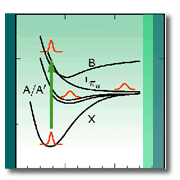| |
 |

GAS
KINETICS AND PHOTOCHEMISTRY.
Coordinator:
Dr. C. J. Cobos
Time resolved studies, typically on a microsecond timescale, of elemental chemical reactions of
fluorocarbonated and fluorosulphurated compounds of real or potential interest in atmospheric chemistry
are performed. A laser flash photolysis technique employing UV light pulses from an excimer laser and
UV/Vis absorption spectroscopy is applied. The study of reactions between fluorine atoms or small
halogenated radicals with molecules or radicals of atmospheric interest is emphasized. Rate coefficients
of fast processes are determined as a function of temperature and, for collision-assisted assisted
reactions, as a function of the nature and pressure of the stabilizing gas.
Manometric and spectrophotometric techniques are also applied to study the kinetics and mechanisms of
thermal and photochemical reactions of chlorine oxides and the oxidation reactions of chloroethenes,
among others.
Transition state theory and the statistical adiabatic channel model on potential energy surfaces based
on ab initio and density functional theory are applied to study elemental chemical reactions of interest
in interstellar, stratospheric and combustion chemistry. Ab initio and density functional calculations are
also employed to investigate the stability and thermochemistry of organic and halogenated compounds,
radical reactivity and transition states properties.
Critical evaluations of kinetic studies in collaboration with several foreign laboratories, in particular,
the recommendation of kinetic data of general interest and of interest in atmospheric and combustion
chemistry are performed.
Since
2005, the Division is a Partner Group of the Max Planck Institute for
Biophysical Chemistry, Goettingen, Germany.
|
| |
|
Selected
publications in the frame of this project (2007 - 2008)
* “Reactions of sulphate radicals with substituted pyridines: a structure-reactivity correlation analysis”.
M.L. Dell' Arciprete, C.J. Cobos, J.P. Furlong, D.O. Mártire y M.C. Gonzalez
ChemPhysChem 8, 2498 - 2505 (2007).
* “Side-on versus end-on bonding of O2 to the FSO3 radical: Matrix isolation and ab initio study of FSO5”.
H. Beckers, P. Garcia, H. Willner, G.A. Argüello, C.J. Cobos y J.S. Francisco
Angewandte Chemie International Edition 46, 3595-3605 (2007).
* “Ab initio and DFT study of the molecular conformations and the thermochemistry of the CH2=CHC(O)OONO2 (APAN) atmospheric molecule and of the CH2=CHC(O)OO and CH2=CHC(O)O radicals”.
M.P. Badenes y C.J. Cobos
Journal of Molecular Structure (Theochem) 814, 51-60 (2007).
* “Evidences for a new ultraviolet absorption band of the FSO3 radical”.
C.J. Cobos y A.E. Croce
Zeitschrift für Physikalische Chemie 221, 897-909 (2007).
* “Direct DFT trajectory study of the bis-superoxo FAl(O2)2 ionization”.
C.J. Cobos
Zeitschrift für Naturforschung A 63, 49-52 (2008).
* “Experimental and quantum chemical study of the oxidation mechanism of CF2CFBR by O2”.
M.P. Badenes, J. Czarnowski y C.J. Cobos
Zeitschrift für Physikalische Chemie 222, 1083-1094 (2008).
* “The photochemical decomposition of gaseous OClO at 436 nm: dependence of products distribution on total pressure”.
A.E. Croce, M.I. López y J.E. Sicre
Journal of Photochemistry and Photobiology A: Chemistry 196, 67-76 (2008).
* “Thermal gas-phase reaction of perfluorobuta-1,3-diene with NO2”.
J. Czarnowski
Journal of Fluorine Chemistry 129, 261-266 (2008).
* “Quantum chemical study of the atmospheric C2H5C(O)OONO2 (PPN) molecule and of the C2H5C(O)OO and C2H5C(O)O radicals”.
M.P. Badenes y C.J. Cobos
Journal of Molecular Structure (Theochem) 856, 59-70 (2008).
* “Gaussian-3 study of the thermochemistry of the germane and its fluoro chloro derivatives”.
P.R. Duchowicz y C.J. Cobos
Journal of Physical Chemistry, Part A 112, 6198-6204 (2008).
* “Experimental and theoretical study of the recombination reaction FSO2+O2?FS(O2)OO”.
M.E. Tucceri, M.P. Badenes, A.E. Croce y C.J. Cobos
Chemical Physics Letters 465, 15-19 (2008).
* “First order paralell and consecutive reaction mechanisms: isosbestic points criterium”.
A.E. Croce
Canadian Journal of Chemistry 86, 918-924 (2008).

|


